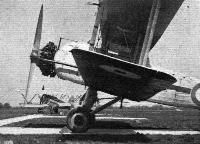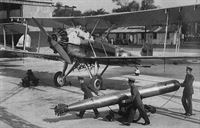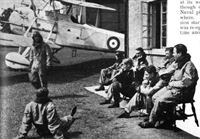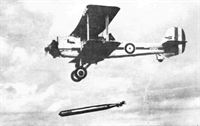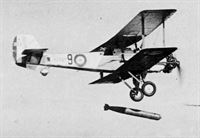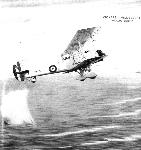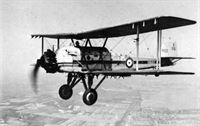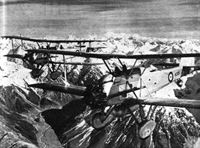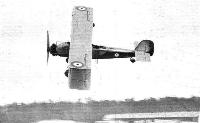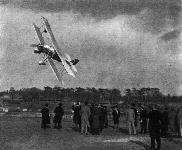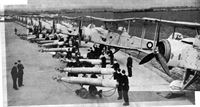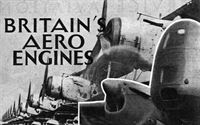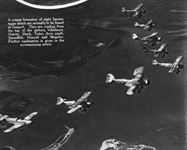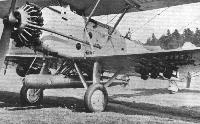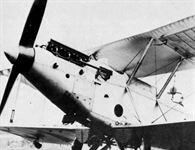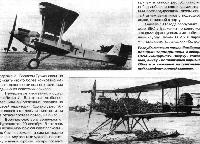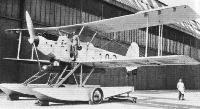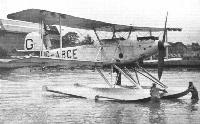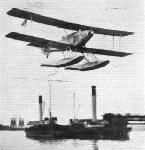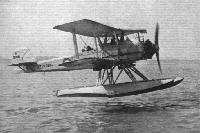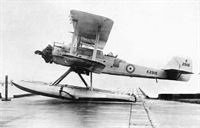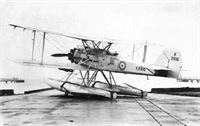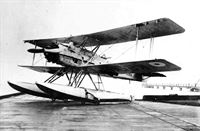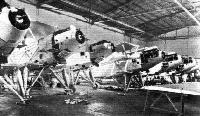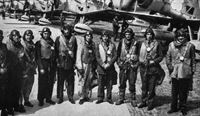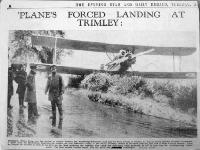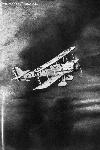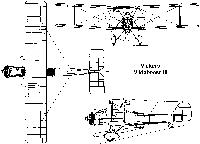
Варианты
- Vickers - Vildebeest / Type 132 - 1928 - Великобритания
- Vickers - Vincent / Type 266 - 1932 - Великобритания
Vildebeest / Type 132
Базовый одномоторный торпедоносец и бомбардировщик, цельнометаллический биплан с неубирающимся шасси (на некоторых сериях колеса заключены в каплевидные обтекатели). Спроектирован в КБ фирмы "Виккерс авиэйшн" под руководством Р. Пирсона. Первый полет опытный образец самолета совершил в апреле 1928 г. Серийное производство начато в сентябре 1932 г. Выпускался заводами "Виккерс" в Уэйбридже и CASA в Кадисе (Испания). Всего построено 209 экз. (в т.ч. 25 в Испании).
Состоял на вооружении в Великобритании с января 1933 г., Испании - с марта 1932 г., Новой Зеландии - с марта 1935 г.
Вооружение 2x7,69, бомбы до 750 кг или одна торпеда (780 кг) наружно.
Выпускались следующие модификации:
- "Уайлдбист" I, мотор "Пегасус" IM3, экипаж - 2 чел.;
- экспортная модификация для Испании (тип 245) с мотором HS 12Lbr на базе "Уайлдбист" I;
- "Уайлдбист" II, мотор "Пегасус" IIM3, измененное хвостовое оперение, экипаж - 2 чел., на поздних сериях ликвидирован подфюзеляжный киль;
- "Уайлдбист" III, трехместный вариант модификации II, для Новой Зеландии выпущена серия со складными крыльями и без торпедной подвески;
- "Уайлдбист" IV, мотор "Персеус" VIII, экипаж - 2 чел.
Самолет снят с производства в ноябре 1937 г.
Первое боевое применение - в гражданской войне в Испании в 1936 г. (на стороне республиканцев). К концу 1941 г. машины модификаций III и IV еще сохранились в эскадрильях, дислоцированных в Малайе и Сингапуре, и приняли участие в боевых действиях против японского флота и армии. После падения Сингапура они продолжали воевать на Яве и Борнео до марта 1942 г., когда были потеряны последние два самолета.
Новозеландские машины патрулировали прибрежные воды в поисках японских подводных лодок с конца 1941 г. до весны 1942 г.
"Уайлдбист" IV||
Размах:||14,94 м
Длина:||11,48 м
Моторы, количество х мощность:||1x825 л.с.
Взлетная масса, максимальная:||3864 кг
Максимальная скорость:||251 км/ч
Практический потолок:||5180 м
Дальность (с торпедой):||1080 км
Описание:
- Vildebeest / Type 132
- Vickers Type 132 Vildebeest/Type 266 Vincent
- Flight, November 1931
The Vickers "Vildebeest” - Flight, April 1932
Vickers "Vildebeest" TORPEDOPLANE - Flight, November 1932
British Aircraft
Фотографии
-
АвиаМастер 2002-08 / М.Жирохов, И.Сеидов - Яростное небо Эускади /Из истории воздушных войн/
Бомбардировщик-торпедоносец ВВС испанского республиканского флота Виккерс CASA "Уайлдбист" HS-12N.b.r. и эмблема эскадрильи морской авиации.
-
Flight 1930-11 / Flight
Vickers Vildebeest torpedo-plane and bomber.
-
Flight 1936-09 / Flight
GOSPORT CAMEO: A Blackburn Shark (Siddeley Tiger) and a Vickers Vildebeest (Bristol Pegasus) used for development work with torpedoes at Gosport. Both types (classed officially as torpedo bombers), although well established in service, are still in quantity production. Certain Vildebeests are receiving Perseus sleeve-valve engines.
Другие самолёты на фотографии: Blackburn Shark / B-6 - Великобритания - 1933
-
Flight 1929-07 / Flight
THE VICKERS VILDEBEEST: A two-seater Torpedoplane with Bristol Jupiter VIII Engine.
-
Aeroplane Monthly 1997-12 / G.Tuff - A life in service
Регистрационный номер: S1712 [2] Торпедоносец "Уайлдбист" III, аэродром Госпорт (Англия)
Another day at Gosport, with a torpedo being taken to its aircraft. Vildebeest Mk I S1712 stands behind, and the tail of a Ripon may be seen on the left.
Vildebeest I S1712 with 18-inch torpedo at GosportДругие самолёты на фотографии: Blackburn Ripon / T.5 - Великобритания - 1926
-
Aeroplane Monthly 1987-09 / Personal album
Регистрационный номер: K2939 Vickers Vildebeest II K2939 was one of 30 machines delivered to the RAF between June and August 1935. Delivered initially to 100 (Torpedo Bomber) Squadron, K2939 was attached to the Station Flight at Kai Tak and appears to be equipped for target towing duties. K2939 was ditched in the Lyemun Pass, Hong Kong on May 23, 1939. Powered by a 635 h.p. Pegasus IIMB radial engine, the Vildebeest II carried a l,100lb torpedo and was armed with one forward-mounted Vickers gun and a Lewis gun aft.
-
Авиация и Космонавтика 2022-02 / В.Морозов - "Битва" за Сингапур (2)
Регистрационный номер: NZ102 [2] Торпедоносец Виккерс «Вайлдебест» в камуфляжной раскраске. Юго-Восточная Азия. Фото 1939-1941 гг.
-
Flight 1940-01 / Flight
Регистрационный номер: NZ102 [2], NZ110 Vickers Vildebeests of the Royal New Zealand Air Force. These are used for bombing, reconnaissance and training and not for torpedo dropping as with the R.A.F.
This view of a line of RNZAF Vildebeest IIIs gives some idea of the pilot’s lofty position in this torpedo bomber. RNZAF Vildebeests differed from RAF aircraft in that they had folding wings. -
Авиация и Космонавтика 2022-01 / В.Морозов - "Битва" за Сингапур (1)
Самолеты Виккерс «Вайлдебест» на фоне ангаров. Середина 1930-х гг.
-
Flight 1938-07 / Flight
An informal group: officers under instruction awaiting their turns to fly. They are mostly Naval officers, but the possession of a moustache in one case indicates a military man.
-
Авиация и Космонавтика 2022-01 / В.Морозов - "Битва" за Сингапур (1)
Штурман «Вайлдебеста» передает техникам бортовую фотокамеру.
-
Air-Britain Aeromilitaria 1985-01
Регистрационный номер: K2927 [2] Vildebeest II K2927 of No.100 Squadron at Seletar
-
Flight 1932-06 / Flight
Регистрационный номер: N230 [2] A Vickers "Vildebeest" (Bristol "Pegasus") with which No.100 B.S. is to be re-equipped this summer.
-
Flight 1932-07 / Flight
Регистрационный номер: N230 [2] FOR No. 100 (BOMBER) SQUADRON: The Vickers "Vildebeest" Torpedoplane ("Pegasus").
-
Flight 1933-08 / Flight Advertisements
Vickers "Vildebeest" Pegasus Engine
-
Flight 1939-10 / Flight
SAME WEAPON, DIFFERENT ELEMENTS: A Vickers Vildebeest used for training pilots in the art of torpedo-dropping seen over a British submarine which also specialises in attacks with torpedoes. These are of heavier patterns.
-
Air-Britain Aeromilitaria 1985-01
Регистрационный номер: K2822 K2822 was one of a batch of 13 Vildebeest Is and was flown by No.100 Squadron in the UK
-
Air-Britain Aeromilitaria 1985-01
Регистрационный номер: K2814 [2] The Vickers Vildebeest torpedo bomber, with 590 h.p. Pegasus II M, is used for coastal defence.
Vildebeest I K2814 of RAF Base Gosport on torpedo practice -
Flight 1936-05 / Flight
Регистрационный номер: K2814 [2] It was not possible to show the public any actual torpedo dropping at Gosport on Empire Air Day, but this picture, secured beforehand, depicts the "tinfish" a moment after its release.
-
Aeroplane Monthly 1984-05 / N.Hearn-Phillips - Pilot's progress
Here we see a Vildebeest dropping a practice torpedo in Stokes Bay.
-
Aeroplane Monthly 1997-12 / G.Tuff - A life in service
A Gosport-based Vickers Vildebeest Mk I releases its “tinfish” during torpedo-dropping training in the late 1930s.
-
Aeroplane Monthly 1991-09 / D.Edwards - Flights and frights in the thirties (6)
Регистрационный номер: S1710 [2] Vickers Vildebeest S1710 releases its torpedo onto a target. This aircraft was operated by A Flight at Gosport and later passed to 4 School of Technical Training as 1187M.
-
Air-Britain Aeromilitaria 1985-01
Регистрационный номер: K4176 [2] K4176 of No.26 Squadron flies along the Singapore waterfront in 1926. It was lost attacking a Japanese convoy on 26.1.42
-
Авиация и Космонавтика 2022-01 / В.Морозов - "Битва" за Сингапур (1)
Регистрационный номер: K4176 [2] Торпедоносец Виккерс «Вайлдебест» Мк.П из 36-й аз летит над гаванью Сингапура. Фото периода 1936-1939 гг.
-
Air-Britain Aeromilitaria 1985-01
Регистрационный номер: K2927 [2] Vildebeest II K2927 of No.100 Squadron over Johore Strait
-
Flight 1933-11 / Flight Advertisements
Регистрационный номер: S1707 [2] -
Flight 1935-05 / Flight
"Vildebeest"
-
Aeroplane Monthly 1984-05 / N.Hearn-Phillips - Pilot's progress
Регистрационный номер: K4589 At Thorney Island we flew Vildebeests. Here is the Vildebeest Mk III, with the 660 h.p. Pegasus IIM3 engine.
-
Air-Britain Aeromilitaria 1980-04
Регистрационный номер: S1710 [2] Vildebeest I S1710 from Gosport over Fareham, Hants
-
Air-Britain Aeromilitaria 1985-01
Регистрационный номер: K2936 One of No.100 Squadron's Vildebeest IIIs over Singapore
-
Air-Britain Aeromilitaria 1985-01
Регистрационный номер: K4163 Vildebeest III K4163 from Gosport toured RAF stations on Empire Air Day, 1937
-
Flight 1938-08 / Flight
Регистрационный номер: NZ105 PUTTING THEIR TRUST IN PEGASUS: Vickers Vildebeestes of the Royal New Zealand Air Force flying at 13,000ft. over no sort of country for forced landings. The scene is the Southern Alps of New Zealand and the temperature, according to the photographer, was to deg. below zero. Beneath the nearest machine is a long-range tank.
-
Jane's All the World Aircraft 1938 / 02 - The progress of the world in military aviation during the year 1937-38
Регистрационный номер: NZ111 Vickers "Vildebeests" of the Royal New Zealand Air Force in formation with Mount Ngauruhoe in the background.
-
Flight 1939-02 / Flight
A flight of Vickers Vildebeest bombers (Bristol Pegasus engine) of the Royal New Zealand Air Force.
-
Flight 1936-07 / Flight
IN MALAYA: Vickers Vildebeest aircraft of No. 36 (Torpedo - Bomber) Squadron flying over the country round Singapore.
-
Flight 1935-04 / Flight Advertisements
THE VICKERS "VILDEBEEST." Fitted with a "Bristol" Pegasus Engine for use either as a bomber or torpedoplane, this aircraft is notable for its weight-carrying capabilities, the disposable load being nearly two tons. The Pegasus-engined "Vildebeest" is in full production in the establishment of Messrs. Vickers (Aviation) Ltd., Brooklands, and has been adopted as standard equipment by the Royal Air Force and by the Government of New Zealand. Already several squadrons operating in various parts of the world are equipped with this machine.
-
Flight 1935-02 / Flight
NEW ZEALAND'S CHOICE. Sir James Parr, High Commissioner for New Zealand, last week attended Brooklands for a demonstration of one of the twelve "Vildebeests" which have been ordered for coast defence work. Mr. J. Summers, Vickers' chief test pilot, treated Sir James and a large party of visitors to a brilliant display of flying.
-
Air-Britain Aeromilitaria 1985-01
Vildebeests of 100 Sqn being refuelled at Kuala Lumpur in 1938. Note the bystanders in the shade under the wing.
-
Jane's All the World Aircraft 1980 / Encyclopedia of Aviation - Aircraft A-Z - v5
Vickers Vildebeest IV (left) and Vildebeest II.
-
Flight 1935-05 / Flight
ON DUM DUM AERODROME: The Vickers "Vildebeests" ("Pegasus") of No. 100 (Bomber) Squadron at Calcutta en route for Risalpur from Singapore. The return journey amounted to 7,000 miles.
-
Flight 1939-02 / Flight Advertisements
Подготовка к подвеске торпед на самолеты "Уайлдбист" IV 42-й эскадрильи
Bristol Perseus-engined Vickers Vildebeest IV torpedo bombers of No. 42 (T.B.) Squadron, the first standard military aircraft to be fitted with sleeve-valve engines and detachable-blade wooden airscrews They are seen at Thomey Island, complete with “tinfish.” -
Flight 1938-09 / Flight
Fixing the "tin fishes." The levers on the trolley raise the torpedo into the carriers under the Vildebeest.
-
Aeroplane Monthly 1985-02 / L.Coombs - The expanding years 1936-1939 (4)
Регистрационный номер: K6409 [3], K8086 [2] Vickers Vildebeests of 42 Squadron. The type was the RAF's only torpedo bomber at the outbreak of war.
-
Flight 1939-05 / Flight
Регистрационный номер: K6409 [3], K8086 [2] A reassuring line-up of Vickers Vildebeest IV torpedo bombers.
-
Flight 1938-05 / Flight
Регистрационный номер: K4164 [5] VICKERS VILDEBEEST: Torpedo bomber (Pegasus IIM engine - 635 h.p. at 5,000ft.); span, 49ft.; gross weight, 8,100 lb.; max. speed, 142 m.p.h. at 4,930ft. (Picture shows Vildebeest IV with Perseus engine.)
-
Aviation Historian 11 / M.Willis - From Farmer to Test Pilot /Duncan Menzies/ (1)
Регистрационный номер: K4164 [5] The second aircraft in which Menzies had to make a forced landing after engine failure while at the A&AEE was Vickers Vildebeest III K4164, seen here following its conversion to Mk IV configuration. On January 7, 1935, Menzies experienced engine failure in the aircraft and had to put down in a field near Trimley St Martin in Suffolk.
-
Aviation Historian 6 / D.Menzies - "A Very Audible Remark..."
Регистрационный номер: K4164 [5] THE SAME ONLY DIFFERENT: Anyone could be excused for saying of the above view "It's an ordinary Vickers Vildebeest as used by the R.A.F." But that is not true. Note, for instance, that a long-chord cowling is fitted; this is not standard on the present Pegasus-engined type. Actually the machine has a Bristol Perseus sleeve-valve engine and is of a type adopted as Service equipment by the Air Ministry.
Vickers Vildebeest K4164, the aircraft in which Menzies made his forced landing in January 1935, following its conversion from a Pegasus-engined Mk III to the testbed for the Bristol Perseus-powered Vildebeest Mk IV. -
Aeroplane Monthly 1984-05 / N.Hearn-Phillips - Pilot's progress
A formation of 22 Squadron Vildebeest is seen setting course over Chichester Harbour to attack the Navy in combined services exercises in the Channel.
-
Flight 1938-04 / Flight
Регистрационный номер: K8080 В полете - звено самолетов "Уайлдбист" IV из 42-й эскадрильи
SLEEVE-VALVES IN SERVICE: Vickers Vildebeest IV torpedo bombers (Bristol sleeve-valve Perseus VIII) approach the “convoy” during the recent Combined Exercises. -
Flight 1938-09 / Flight
Регистрационный номер: K6409 [3], K6411, K6413 Трехместный Vildebeest Mk III стал основной серийной модификацией и в 1930-х годах был основным торпедоносцем-бомбардировщиком сухопутного базирования. На фотографии - самолеты из 42-й эскадрильи.
A flight of Vildebeests. Note the angle at which the torpedoes are carried. -
Air-Britain Aeromilitaria 1985-01
Vildebeest IIIs of No.22 Squadron over north-east Malta while based at Hal Far during the Abyssinian crisis of 1935/36
-
Air-Britain Aeromilitaria 1985-01
A formation of No.100 Squadron Vildebeests taken in June 1928
-
Flight 1938-09 / Flight
Not a ghost squadron: Our photographer has caught the formation at a moment when some trick of light on a dull day shows the machines up vividly against the ground. Their usual duties, however, take them over the sea where their silvery paint would not make them so conspicuous.
-
Flight 1938-04 / Flight
OVER THE CHANNEL: Vildebeests of No. 42 (T.B.) Squadron on the way to torpedo a "convoy" in the Channel seen from the gunner's cockpit of a consort.
-
Aeroplane Monthly 1988-06 / Personal album. Military
Superb photograph of Hawker Hart Trainer K6426 in company with Vickers Vildebeests. This Hart flew with the Straits Settlements Volunteer Air Force until it crashed during an aerobatic display at Penang airfield on March 6, 1938.
Другие самолёты на фотографии: Hawker Hart - Великобритания - 1928
-
Flight 1938-09 / Flight
Torpedo attack on a ship: Two Vildebeests have levelled out and are aiming at the vessel, while a third is still diving down from the height at which the approach was made.
-
Flight 1938-09 / Flight
This striking photograph shows No. 42 (T.B.) Squadron in formation over one of the inlets of the South Coast. This is the only squadron equipped with the Vickers Vildebeest IV driven by the Bristol sleeve-valve Perseus engine.
-
Flight 1936-07 / Flight
THE KING'S BIRTHDAY AT MALTA: A squadron of Vickers Vildebeests flying past H.E. the Governor, Sir Charles Bonham-Carter.
-
Aeroplane Monthly 1994-12 / G.Wansbrough-White - What's in a name? (2)
A formation of eight types based at Gosport in 1938. They are, from the top, Vildebeest, Osprey, Shark, Tutor, Avro 504N, Swordfish, Nimrod and Magister. The 504N was flying at full bore while the Kestrels of the Nimrod and Osprey were throttled well back. Pilots of this “Heinz” formation were drawn from the RAF, Army, Navy and Marines; the aircraft came from the Coastal Defence Development Flight and the Torpedo Training Unit.
Другие самолёты на фотографии: Avro Avro 504N - Великобритания - 1920Avro Tutor/Sea Tutor/Prefect / Type 621/646/626 - Великобритания - 1929Blackburn Shark / B-6 - Великобритания - 1933Fairey Swordfish - Великобритания - 1934Hawker Nimrod - Великобритания - 1931Hawker Osprey - Великобритания - 1930Miles Magister / M.14 - Великобритания - 1937
-
Flight 1938-05 / Flight
A unique formation of eight Service types which are normally to be found at Gosport. They are, reading from the top of the picture, Vildebeest, Osprey, Shark, Tutor, Avro 504N, Swordfish, Nimrod and Magister.
Другие самолёты на фотографии: Avro Avro 504N - Великобритания - 1920Avro Tutor/Sea Tutor/Prefect / Type 621/646/626 - Великобритания - 1929Blackburn Shark / B-6 - Великобритания - 1933Fairey Swordfish - Великобритания - 1934Hawker Nimrod - Великобритания - 1931Hawker Osprey - Великобритания - 1930Miles Magister / M.14 - Великобритания - 1937
-
Flight 1939-03 / Flight
A Vildebeest torpedo bomber makes a dive-bombing attack.
-
Flight 1934-06 / Flight
"MILITARY LOAD" - AND MORE. An 18-in. torpedo and an assortment of bombs on a Vickers "Vildebeest" torpedo bomber. Bombs and torpedo are alternative loadings. It is not possible to carry both at the same time.
-
Air-Britain Aeromilitaria 1985-01
The Hispano engine of the Spanish Vildebeest with exposed forward-firing Vickers gun
-
Flight 1932-04 / Flight
AS A LANDPLANE: View of the "Vildebeest" in the act of dropping its torpedo.
-
Flight 1932-04 / Flight
The photograph gives a good idea of the small amount of spray created by the torpedo on striking the water.
-
Flight 1932-05 / Flight
BRITISH AIRCRAFT IN SPAIN: As previously reported in "Flight," a Vickers "Vildebeest" torpedo carrier was recently delivered to the Spanish Government at Madrid - the first of an order of 26 machines. Our picture shows the machine at Madrid, when a successful demonstration was carried out by Mr. H. W. R. Banting.
-
Aeroplane Monthly 1986-09 / Personal album
One of 25 licence-built Vickers Vildebeests built for the Spanish Navy by Construcciones Aeronauticas SA (CASA) of Cadiz. They were delivered during 1935 and formed the Escuadrilla de Torpederos at San Javier.
-
АвиаМастер 2002-08 / М.Жирохов, И.Сеидов - Яростное небо Эускади /Из истории воздушных войн/
Республиканские легкие бомбардировщики-торпедоносцы Виккерс CASA "Уайлдбист". Вверху - колесный, внизу - поплавковый вариант. Обратите внимание на оригинальный камуфляж нижней машины.
-
Flight 1931-09 / Flight
Регистрационный номер: G-ABGE [4] ON TOUR: A Vickers "Vildebeest" torpedo bomber (Hispano-Suiza) fitted as a twin-float seaplane which is being sent on a tour of the ports of Northern Europe. It is being piloted by Capt. H. C. Biard.
-
Flight 1932-04 / Flight
Регистрационный номер: G-ABGE [4] AS A SEAPLANE: The "Vildebeest" in full flight. The upper photograph shows the machine as a landplane, with the torpedo in place.
-
Flight 1931-11 / Flight
Регистрационный номер: G-ABGE [4] LAUNCHING THE "VILDEBEEST": The machine is run down the slipway on its beaching wheels. Note the water rudders on the floats. The pilot's cockpit is in front of the wings, just behind the engine.
-
Aeroplane Monthly 1984-10 / Personal album
Регистрационный номер: G-ABGE [4] In 1930 the prototype Vickers Vildebeest, N230, was modified for exhibition at the Paris Air Show. The original Jupiter XF engine was replaced with a Jupiter XIF with Townend ring. Registered G-ABGE for the show, the aircraft was modified further and flown on a sales tour of Baltic ports. This photograph was taken during the tour at Santahamina, Helsinki. A Finnish Air Force Blackburn Ripon is seen at right.
Другие самолёты на фотографии: Blackburn Ripon / T.5 - Великобритания - 1926
-
Flight 1931-11 / Flight
TAKING OFF: This photograph shows the good view forward and downward from the pilot's cockpit.
-
Flight 1931-11 / Flight
THE "VILDEBEEST" IN FLIGHT: The shape of the float bottoms, steps, etc., may be seen in this photograph.
-
Flight 1936-06 / Flight
Регистрационный номер: K2916 [5] A Vickers Vildebeest floatplane, equipped as a bomber, in the act of touching down at Felixstowe after a test flight.
-
Air-Britain Aeromilitaria 1980-02
Регистрационный номер: K2916 [5] With committments in areas which often had more water than dry land suitable for airfields the Royal Air Force between the wars maintained a keen interest in seaplanes and many standard types were tested at the Marine Aircraft Experimental Establishment, Felixstowe, for their suitability as floatplanes.
One of these was the first Vildebeest II, K2916, depicted in the following photographs. As well as RAF use, there was also interest in a seaplane version of the Vildebeest for Latvia. -
Air-Britain Aeromilitaria 1980-02
Регистрационный номер: K2916 [5] -
Air-Britain Aeromilitaria 1980-02
Регистрационный номер: K2916 [5] -
Flight 1934-11 / Flight
The "Vildebeest" ("Pegasus") Torpedo Bomber.
-
Air-Britain Aeromilitaria 1980-02
Регистрационный номер: K2916 [5] -
Flight 1935-12 / Flight
A cockpit bag is carried on the Vickers Vildebeest torpedo bomber. It is normally stowed in the top portion of the fuselage but is inflated automatically when the Vildebeest enters the water
-
Flight 1936-12 / Flight
FIRST IN SERVICE: This view shows to advantage the installation of a moderately supercharged Bristol Perseus sleeve-valve engine in a Vickers Vildebeest torpedo-bomber. This combination has been adopted by the Air Ministry and marks the entry of sleeve-valve engines into the Service
-
Flight 1936-01 / Flight
SPANISH-BUILT: Some of the Spanish Air Force Vickers Vildebeest torpedo-bombers under construction at the Getafe, Madrid, works of Construcciones Aeronauticas S.A., who are building them under licence from Vickers (Aviation) Ltd. Twenty-six have recently been completed, with wheel undercarriages, while conversion sets to enable the machines to be used as twin-float seaplanes have also been produced by the C.A.S.A. Hispano Suiza engines are fitted. It is stated that the naval authorities, in particular, are extremely pleased with the Vildebeests.
-
Aeroplane Monthly 1979-02 / F.Adkin - Memoirs of Aircraftsman (2)
Регистрационный номер: K2817 [2] Embryo aircraftmen at another RAF school, the Technical Training School (Apprentices) at Halton, undergo blackboard instruction with Vickers Vildebeest 969M/K2817 and Westland Wallace 604M/K3665 behind.
Другие самолёты на фотографии: Westland Wallace / PV.3 / PV.6 - Великобритания - 1931
-
Aeroplane Monthly 1994-05 / J.Painter - A wartime brat
Регистрационный номер: K2817 [2] Halton apprentices sit in the April sunshine in 1938 as the mysteries of the aero-engine are unravelled with the help of an aged Vildebeest and an Osprey.
Другие самолёты на фотографии: Westland Wallace / PV.3 / PV.6 - Великобритания - 1931
-
Flight 1938-09 / Flight
Регистрационный номер: K8084 Some pilots of No. 42 (T.B.) Squadron. Left to right: Sgt. N. B. Harvey, Sgt. F. D. Flinn, Sgt. G. S. Forbes, Sgt. G. S. Turner, P/O. G. S. P. Rooney, F/O. W. H. Cliff, F/O. J. S. Tupho'me. F/O. D. B. M. Wright, F/O. A. Hibberd, Sqn. Ldr. G. C. Bladon
-
Aviation Historian 6 / D.Menzies - "A Very Audible Remark..."
Регистрационный номер: K4164 [5] -
Aviation Historian 6 / D.Menzies - "A Very Audible Remark..."
Регистрационный номер: K4164 [5] The report of the forced landing in local newspaper The Evening Star and Daily Herald on Tuesday, January 8, 1935, the day after the incident.
-
Aeroplane Monthly 1984-05 / N.Hearn-Phillips - Pilot's progress
The Vildebeest had the unusual, rather vicious Vickers air brakes. Air pressure in the brake system was pumped up to 400lb/in2 in the air or before taxying. Attempts to pump up any more pressure whilst moving could result in something like this.
-
Aeroplane Monthly 1989-04 / Personal album. Military
Регистрационный номер: K4157 Vickers Vildebeest III K4157 was from a batch of 33 delivered to the RAF between October 1934 and March 1935. Initially flown with 22 Squadron, K4157 passed to N Flight at Gosport and was later used by the MAEE for ditching trials. It was broken up in March 1937.
-
Air Enthusiast 2006-09 / A.Thomas - Light Blue Fishes /World war two/
The RAF's first operational use of the Albacore was in Malaya when a few were used alongside the Vildebeeste of 36 Squadron. One of these lies derelict in Singapore, a mute testimony to that ill-fated campaign.
-
Flight 1933-07 / Flight Advertisements
Регистрационный номер: S1714 Vickers "Vildebeest" (Pegasus engine) for "general purpose" duties. The auxiliary fuel tank increases the range from 625 to 1,250 miles.
-
Flight 1935-05 / Flight Advertisements
The Arethusa, an Imperial Airway's Liner of the Atalanta class at Rangoon.
-
Air Enthusiast 1996-05 / H.Woodman - Blackburn Dart. The Fleet Air Arm's Seminal Torpedo Bomber
Although the sketch is from the Vickers Vildebeest manual, the torpedo equipment is that which was standardised until World War Two. It has all the elements developed for the Dart except that there is a reversion to the cartridge release system (as used by the early Shorts). Notable too is the increased nose down attitude of the torpedo which was favoured in the mid 1930s as ensuring a cleaner entry into water. A newer development was the electric heating element within the torpedo.
-
Flight 1935-12 / Flight
This series of sketches, specially prepared by Flight, shows the various types of gear and the flotation angles of certain R.A.F. machines. Those fitted with Youngman dinghies, of course, do not sink immediately.
Другие самолёты на фотографии: Fairey Swordfish - Великобритания - 1934Hawker Hart - Великобритания - 1928Hawker Nimrod - Великобритания - 1931Hawker Osprey - Великобритания - 1930
Тип фотографий
- Все фото (103)
- Боковые проекции (1)
- Ч/б фото (90)
- Обломки (5)
- Рисунки, схемы (7)


